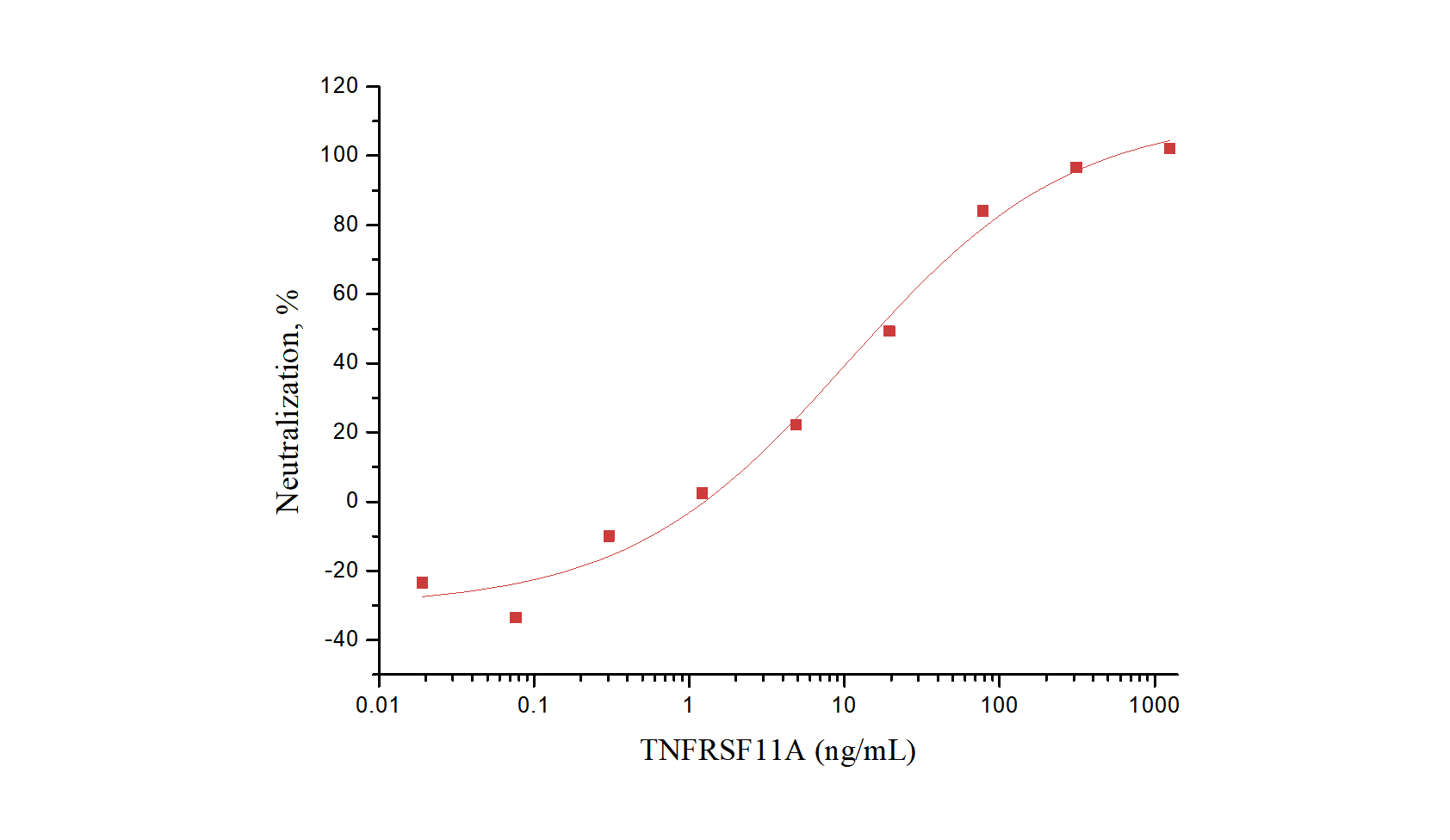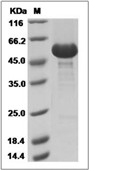Shopping Cart
- Remove All
 Your shopping cart is currently empty
Your shopping cart is currently empty

RANK/TNFRSF11A Protein, Human, Recombinant (hFc) is expressed in HEK293 mammalian cells with hFc tag. The predicted molecular weight is 46.8 kDa and the accession number is Q9Y6Q6-3.

| Pack Size | Price | Availability | Quantity |
|---|---|---|---|
| 100 μg | $451 | In Stock | |
| 200 μg | $761 | 7-10 days | |
| 500 μg | $1,510 | 7-10 days |
| Biological Activity | Measured by its ability to inhibit TRANCE-induced osteoclast differentiation of RAW 264.7 mouse monocyte/macrophage cells. The ED50 for this effect is 3-16ng/mL in the presence of 5 ng/mL of TRANCE.  |
| Description | RANK/TNFRSF11A Protein, Human, Recombinant (hFc) is expressed in HEK293 mammalian cells with hFc tag. The predicted molecular weight is 46.8 kDa and the accession number is Q9Y6Q6-3. |
| Species | Human |
| Expression System | HEK293 Cells |
| Tag | C-hFc |
| Accession Number | Q9Y6Q6-3 |
| Synonyms | tumor necrosis factor receptor superfamily member 11a,TRANCER,TNFRSF11A,RANK,PDB2,OSTS,OPTB7,OFE,ODFR,LOH18CR1,FEO,CD265 |
| Construction | A DNA sequence encoding the human TNFRSF11A (NP_001257879.1) (Met1-Pro212) was expressed with the Fc region of human IgG1 at the C-terminus. Predicted N terminal: Ile 30 |
| Protein Purity | > 90 % as determined by SDS-PAGE  |
| Molecular Weight | 46.8 kDa (predicted); 53.3 kDa (reducing conditions) |
| Endotoxin | < 1.0 EU/μg of the protein as determined by the LAL method. |
| Formulation | Lyophilized from a solution filtered through a 0.22 μm filter, containing PBS, pH 7.4. Typically, a mixture containing 5% to 8% trehalose, mannitol, and 0.01% Tween 80 is incorporated as a protective agent before lyophilization. |
| Reconstitution | A Certificate of Analysis (CoA) containing reconstitution instructions is included with the products. Please refer to the CoA for detailed information. |
| Stability & Storage | It is recommended to store recombinant proteins at -20°C to -80°C for future use. Lyophilized powders can be stably stored for over 12 months, while liquid products can be stored for 6-12 months at -80°C. For reconstituted protein solutions, the solution can be stored at -20°C to -80°C for at least 3 months. Please avoid multiple freeze-thaw cycles and store products in aliquots. |
| Shipping | In general, Lyophilized powders are shipping with blue ice. |
| Research Background | TNFRSF11A is a member of the TNF-receptor superfamily. In mouse, it is also known as CD265. TNFRSF11A contains 4 TNFR-Cys repeats and is widely expressed with high levels in skeletal muscle, thymus, liver, colon, small intestine and adrenal gland. It is an essential mediator for osteoclast and lymph node development. TNFRSF11A and its ligand are important regulators of the interaction between T cells and dendritic cells. It can interact with various TRAF family proteins, through which this receptor induces the activation of NF-kappa B and MAPK8/JNK. Defects in TNFRSF11A can cause familial expansile osteolysis (FEO). FEO is a rare autosomal dominant bone disorder characterized by focal areas of increased bone remodeling. Defects in TNFRSF11A also can cause Paget disease of bone type 2 (PDB2). PDB2 is a bone-remodeling disorder with clinical similarities to FEO. Defects in TNFRSF11A are the cause of osteopetrosis autosomal recessive type 7 which characterized by abnormally dense bone, due to defective resorption of immature bone. |

Copyright © 2015-2025 TargetMol Chemicals Inc. All Rights Reserved.